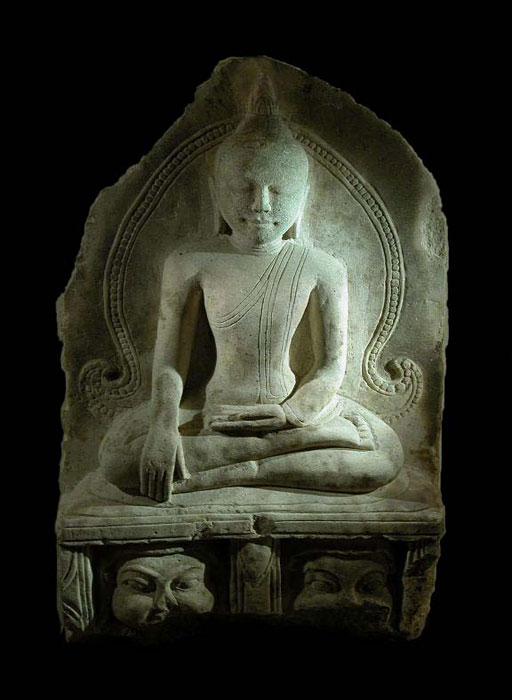
A figure of the Buddha seated in bhumisparimudra on a throne containing two large heads of Mara's army on the front and the sacred hamsa on the sides. The throne back forms a halo with the bottom edges curled up and edged with beading.
Following the Mongol invasion of 1287 the various non-Burman artistic and religious communities which had grown up during the heyday of Pagan (Mon, Pyu, Arakanese, Shan) scattered and returned to their homelands, re-integrating with the communities which they had left either by coercion or voluntarily during the series of campaigns and conquests which had marked out the early centuries of Pagan. They brought with them the skills and aesthetic principles they had absorbed from Pagan but rapidly developed new, quite distinctive styles following the collapse of centralised rule. The various kingdoms into which Burma had fragmented were geographically distant from each other and individual styles developed without major hindrance for several centuries after the fall of Pagan.
This is quite evident in Arakan which despite the hegemony of Pagan had survived as an independent kingdom. The earliest post-Pagan influence on the art of Arakan comes immediately after the Mongol invasion and occupation of the former capital, during the period known in Arakanese chronology as Le Mro. This Buddha stele appears to date from this time. His features and chevron-decorated usnisha are directly influenced by Pagan but the sinuous curves and elaborate carving of his prabha are a departure from the plainer more linear haloes of the Pagan seated Buddhas. Even more strikingly different are the demons from Mara�s vanquished army around the rectangular throne and the plain cushion on which the Buddha sits, instead of the elaborate double lotus typical of Pagan. Figures decorating Maravijaya thrones in the art of Pagan are almost exclusively those of worshippers and donors or of symbolic animals drawn from the Jataka tales.
For comparable examples see:
Gutman, P.; Burma's Lost Kingdoms: Splendours of Arakan, Orchid Press, Bangkok, 2001, pp. 61-72.
Price On Request
Itemcode: C0352-001
|